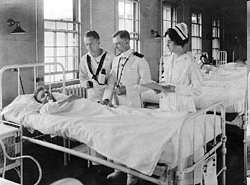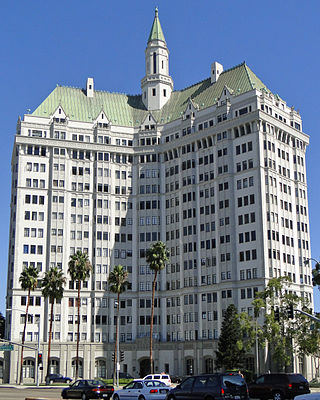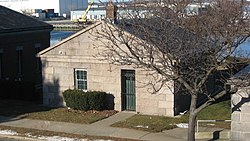
The Boston Navy Yard, originally called the Charlestown Navy Yard and later Boston Naval Shipyard, was one of the oldest shipbuilding facilities in the United States Navy. It was established in 1801 as part of the recent establishment of the new U.S. Department of the Navy in 1798. After 175 years of military service, it was decommissioned as a naval installation on 1 July 1974.

The Washington Navy Yard (WNY) is a ceremonial and administrative center for the United States Navy, located in Washington, D.C. It is the oldest shore establishment of the U.S. Navy, situated along the Anacostia River in the Navy Yard neighborhood of Southeast D.C.

Heslar Naval Armory was constructed in 1936 in Indianapolis, Indiana, United States, on the shore of White River as a Works Progress Administration construction project. It was designed by architect Ben H. Bacon and reflects an Art Moderne style. Heslar Naval Armory was the home of Naval Operations Support Center Indianapolis, Marine Corps Reserve Center Indianapolis, and Naval Recruiting Station Indianapolis, as well as the United States Naval Sea Cadet Corps Cruiser Indianapolis (CA-35) Division and the Central Indiana Young Marines of the Marine Corps League. In October 2008 the Indiana Wing Civil Air Patrol, state branch of the US Air Force Auxiliary, moved its headquarters functions and staff to the Armory.

The Dr. Henry Jacob Bigelow House is a historic house at 72-80 Ober Road in the Oak Hill village of Newton, Massachusetts. Built in 1887, it is one of the last private residences designed by noted American architect Henry Hobson Richardson. It was converted into condominiums in the 1980s by the PBS program This Old House. It was listed on the National Register of Historic Places in 1976.

The Bunker Hill School is a historic school at 68 Baldwin Street in the Charlestown neighborhood of Boston, Massachusetts. Built in 1866, it is a prominent local example of Second Empire architecture, and a surviving example of the city's school planning in the post-Civil War period. Now housing residential condominiums, it was listed on the National Register of Historic Places in 1987.

The Dillaway School is an historic school at 16-20 Kenilworth Street in Boston, Massachusetts. The school was built in 1882 to a design by George Albert Clough, the city's first official architect, and is his only surviving school design in the city. The building was listed on the National Register of Historic Places in 1980, and included in the Roxbury Highlands Historic District in 1989. The building has been converted to residential use.

The George Kunhardt Estate, also historically named Hardtcourt, is a historic estate off Great Pond Road in North Andover, Massachusetts. Built in 1906 for George Kunhardt, a principal owner of textile mills in the Merrimack Valley, the estate later became known as Campion Hall when it served as a Jesuit retreat center. After sitting vacant for many years, the property has been converted into residential condominiums. The property was listed on the National Register of Historic Places on April 22, 1976.

The Block House, also known as Building 9 and the Governors Island Post Hospital, is a brick building in the Nolan Park area of Governors Island in New York Harbor, New York City. Its name is due to its early use as a prison. Ulysses S. Grant was briefly stationed there early in his military career.

The Elizabeth Street School is a historic school building at 31 Elizabeth Street in Worcester, Massachusetts. Built in 1893, it was one of the first commissions for the city by local architect George Clemence, and is stylistically an eclectic mix of Romanesque and Renaissance Revival styles. The building was listed on the National Register of Historic Places in 1980. It has been converted into residences.

The Malvern Road School is a historic school building on Malvern Road and Southbridge Street in Worcester, Massachusetts. Built in 1896 and enlarged in 1907, it is a high quality example of Beaux Arts and Renaissance Revival architecture. It is also significant as a well-preserved work of the local architectural firm Fuller & Delano. The building was listed on the National Register of Historic Places in 1984. The building has been converted to residential condominiums.

Naval Hospital Boston was a hospital in Chelsea, Massachusetts. With the closure of the nearby Boston Navy Yard, the hospital closed in 1974.

The Latrobe Gate is a historic gatehouse located at the Washington Navy Yard in Southeast Washington, D.C. Built in 1806 and substantially altered in 1881, the ceremonial entrance to the U.S. Navy's oldest shore establishment is an example of Greek Revival and Italianate architecture. It was designed by the second Architect of the Capitol Benjamin Henry Latrobe, whose works include St. John's Episcopal Church, the Baltimore Basilica, and the United States Capitol. The Latrobe Gate is one of the nation's oldest extant examples of Greek Revival architecture. It was added to the National Register of Historic Places on August 14, 1973, and is a contributing property to the Washington Navy Yard's status as a National Historic Landmark.

Villa Riviera is a registered historic building on Ocean Boulevard in the Alamitos Beach neighborhood of Long Beach, California, United States. From the time of its completion in 1929 through the mid-1950s, it was the second-tallest building, and the tallest private building, in Southern California. The 16-story Châteauesque building has been called the city's "most elegant landmark" and a building that "has helped define the city." The building was added to the National Register of Historic Places in 1996 and is currently used as condominiums with approximately 134 units, including two penthouse apartments occupying the 16th floor of the building, complete with gargoyles adorning both sides of the bay windows overlooking the city and ocean.

The Charleston Naval Hospital Historic District is a portion of the Charleston Navy Base that included a collection of buildings connected with the medical needs of the Navy base.

The Dickinson County Courthouse and Jail is an historic complex of governmental buildings located at 700 South Stephenson Avenue in Iron Mountain, Michigan. On May 15, 1980, the complex was added to the National Register of Historic Places.

The Chelsea Commercial Historic District is a historic district located along both sides of Main Street from Orchard to North Street in Chelsea, Michigan; the district also includes the adjacent 100 blocks of Jackson, East Middle, and West Middle Streets, as well as structures on Park, East, and Orchard Streets. It was listed on the National Register of Historic Places in 2011.

Charleston Navy Yard Officers' Quarters Historic District is a national historic district located at the former Charleston Naval Shipyard in North Charleston, South Carolina. It encompasses 24 contributing buildings, 2 contributing sites, 1 contributing structure, and 1 contributing object. The site represents development of the upper echelon of senior military housing, support structures, sports facilities and recreational landscape features from 1901 through 1945. The buildings reflect late Victorian and early-20th century eclectic designs including the Italianate, Neo-Classical, Italian Renaissance Revival, Colonial Revival, and the Works Progress Administration (WPA) designed Panama House style.

Brooklyn Naval Hospital was a hospital in Brooklyn, New York City, within the Brooklyn Navy Yard. It was one of the oldest naval hospitals in the United States, having operated from 1838 to 1948. Two of the structures in the former hospital's site are designated New York City Landmarks. The entire hospital complex is listed on the National Register of Historic Places along with the rest of the Navy Yard.

The Hospital Reservation Historic District is located between Radio Station and Officers Row Historic Districts and east of the Marine Reservation Historic District of the Puget Sound Naval Shipyard in Washington, United States. Established in 1909, it reached its maximum development in 1942. The following structures no longer remain:
- ‘"Main Hospital Building"’ (1911,1924): a Neo-Classical, two story with basement brick complex.
- "’Recreation building"’ (1920): two story vernacular wood frame structure with basement; to the west was a yard cemetery, which was relocated to the Presidio in San Francisco, California.
- "’Navy Female Nurse Corps Quarters"’ (1921) was a two-story wood frame structure.
- "’Three Isolation Buildings"’ (1915) were located of the main hospital. Along with other buildings constructed here, all but one isolation building were eventually connected to the main hospital building.
The Marine Reservation Historic District is in the northwestern area of the Puget Sound Naval Shipyard, just west of the Hospital Reservation Historic District. Beginning in 1911 it reached its maximum development, prior to World War II. The district included four standing buildings and a barracks, which has been demolished. The barracks was a 3+1⁄2-story brick building similar in design to the other buildings. All of the buildings face the Marine parade ground, which is used as a playfield. The four two-story quarters of brick have Colonial Revival influences in the Georgian Colonial details. Quarters M-l, M-2 and M-3 were designed by Washington, D.C. architect J.H. DeDibour in 1910. The district is a man-made bench cut into the hillside. Each building has a front, side and rear lawn, native plantings and garden areas. The garages were built in the 1930s.























